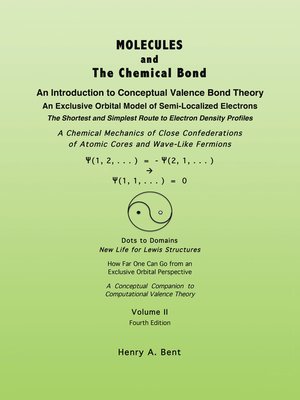Molecules and the Chemical Bond
ebook ∣ An Introduction to Conceptual Valence Bond Theory
By HENRY A. BENT

Sign up to save your library
With an OverDrive account, you can save your favorite libraries for at-a-glance information about availability. Find out more about OverDrive accounts.
Find this title in Libby, the library reading app by OverDrive.



Search for a digital library with this title
Title found at these libraries:
| Loading... |
MOLECULES and the Chemical Bond is about understanding Schrdingers equation, for chemical systems.
In his famous Lectures on Physics, Richard Feynman quotes Paul Dirac on what it means to understand an equation. I understand what an equation means, said Dirac, if I have a way of figuring out the characteristics of its solutions without actually solving it. That hits the nail on the head! Its precisely what Conceptual Valence Bond Theory does for Schrdingers equation.
A physical understanding of an equation, adds Feynman, is a completely unmathematical, imprecise, and inexact thing, but absolutely necessary for a physicist. It unfolds in MCB in two stages, described by Newton as a stage of Analysis (a union of observations and inductions) and a stage of Synthesis (use of inductions, accepted as first principles, to explain observations).
The books chief vehicle for creating an intuitive understanding of solutions of Schrdingers equation is the worlds largest and to the authors knowledge, virtually only library of line drawings of exclusive orbital models of chemical species electron density profiles.
By focussing attention on fundamental physical principles and by avoiding use of atomic orbitals and, thereby, mathematical complexities associated with Schrdingers equation (the only source of atomic orbitals), the books essays provide a scientifically sound, student-friendly introduction to modern valence theory.
Repetition of fundamental ideas, here and there, is intended to make individual essays understandable and interesting, each by itself, so that readers may examine them in any order, in leisurely walks, so to speak, in the big garden that is valence theory, picking bouquets to their liking.






